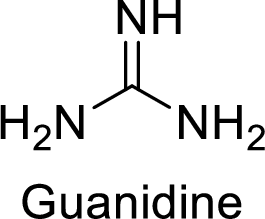
ORGANIC CHEMISTRY-OWL V2 ACCESS
8th Edition
ISBN: 9781305582422
Author: Brown
Publisher: CENGAGE L
expand_more
expand_more
format_list_bulleted
Concept explainers
Question
Chapter 27, Problem 27.34P
Interpretation Introduction
Interpretation:
The Guanidine and Guanidino group present in the amino acid Arginine are the strongest organic bases. Their basicity has to be explained.
Concept Introduction:
The guanidine or guanidino group consists of three

Expert Solution & Answer
Want to see the full answer?
Check out a sample textbook solution
Students have asked these similar questions
Determine whether solutions formed by each salt are acidic, basic or neutral.a. NaHCO3 b. CH3CH2NH3Cl
c. KNO3 d. Fe(NO3)3
Can I please get help with this?
What is the pH of a 0.225 M KOH solution?
Chapter 27 Solutions
ORGANIC CHEMISTRY-OWL V2 ACCESS
Ch. 27.1 - Of the 20 protein-derived amino acids shown in...Ch. 27.2 - Prob. 27.2PCh. 27.2 - Prob. 27.3PCh. 27.3 - Draw a structural formula for Lys-Phe-Ala. Label...Ch. 27.4 - Which of these tripeptides are hydrolyzed by...Ch. 27.4 - Deduce the amino acid sequence of an undecapeptide...Ch. 27.6 - Prob. 27.7PCh. 27 - What amino acid does each abbreviation stand for?...Ch. 27 - The configuration of the chiral center in -amino...Ch. 27 - Assign an R or S configuration to the chiral...
Ch. 27 - Prob. 27.11PCh. 27 - Prob. 27.12PCh. 27 - Draw zwitterion forms of these amino acids. (a)...Ch. 27 - Prob. 27.14PCh. 27 - Why is Arg often referred to as a basic amino...Ch. 27 - Prob. 27.16PCh. 27 - Prob. 27.17PCh. 27 - Prob. 27.18PCh. 27 - Prob. 27.19PCh. 27 - Prob. 27.20PCh. 27 - Both norepinephrine and epinephrine are...Ch. 27 - Prob. 27.22PCh. 27 - Draw a structural formula for the form of each...Ch. 27 - Prob. 27.24PCh. 27 - Write the zwitterion form of alanine and show its...Ch. 27 - Prob. 27.26PCh. 27 - Write the form of aspartic acid most prevalent at...Ch. 27 - Prob. 27.28PCh. 27 - Prob. 27.29PCh. 27 - For lysine and arginine, the isoelectric point,...Ch. 27 - Prob. 27.31PCh. 27 - Account for the fact that the isoelectric point of...Ch. 27 - Prob. 27.33PCh. 27 - Prob. 27.34PCh. 27 - At pH 7.4, the pH of blood plasma, do the majority...Ch. 27 - Prob. 27.36PCh. 27 - Prob. 27.37PCh. 27 - Prob. 27.38PCh. 27 - A chemically modified guanidino group is present...Ch. 27 - Draw a structural formula for the product formed...Ch. 27 - Prob. 27.41PCh. 27 - Prob. 27.42PCh. 27 - A decapeptide has the following amino acid...Ch. 27 - Following is the primary structure of glucagon, a...Ch. 27 - Prob. 27.45PCh. 27 - Draw a structural formula of these tripeptides....Ch. 27 - Estimate the pI of each tripeptide in Problem...Ch. 27 - Glutathione (G-SH), one of the most common...Ch. 27 - Following are a structural formula and a...Ch. 27 - Prob. 27.50PCh. 27 - Prob. 27.51PCh. 27 - Prob. 27.52PCh. 27 - Prob. 27.53PCh. 27 - Prob. 27.54PCh. 27 - Distinguish between intermolecular and...Ch. 27 - Prob. 27.56PCh. 27 - Prob. 27.57P
Knowledge Booster
Learn more about
Need a deep-dive on the concept behind this application? Look no further. Learn more about this topic, chemistry and related others by exploring similar questions and additional content below.Similar questions
- For the reaction: CO2(g) + H2(g) --> CO (g) + H2O (g) Kc= 0.64 at 900 degrees celcius. if initially you start with 1.00 atmoshpere of carbon dioxide and 1 atmoshpere of hydrogen gas, what are the equilibrium partial pressuses of all species.arrow_forwardCan I please get this answered? With the correct number of significant digits.arrow_forwardDraw the Hofmann product of the dehydroiodination of this alkyl iodide. ☐ : + Explanation Check esc F1 2 3 I 88 % 5 F5 I. X © tBuOK Click and drag to sta drawing a structure. © 2025 McGraw Hill LLC. All Rights Reserved. Te BI BB F6 W E R Y S H Karrow_forward
- Can I please get help with this graph, if you could show exactly where it needs to pass through please.arrow_forwardDraw the condensed structure of 1,3-dihydroxy-2-pentanone. Explanation Check Click anywhere to draw the first atom of your structure. Х C © 2025 McGraw Hill LLC. All Rights Reserved. Terms of use +arrow_forward0.500 moles of NOCl are placed into a 1.00 L vessesl at 700K and after the system comes to equilibrium, the consentration of NOCl is 0.440 M. Calculate the equilibrium constant Kc for the reaction: 2NOCL (g) --> 2NO (g) + Cl2 (g)arrow_forward
arrow_back_ios
SEE MORE QUESTIONS
arrow_forward_ios
Recommended textbooks for you
 Introduction to General, Organic and BiochemistryChemistryISBN:9781285869759Author:Frederick A. Bettelheim, William H. Brown, Mary K. Campbell, Shawn O. Farrell, Omar TorresPublisher:Cengage Learning
Introduction to General, Organic and BiochemistryChemistryISBN:9781285869759Author:Frederick A. Bettelheim, William H. Brown, Mary K. Campbell, Shawn O. Farrell, Omar TorresPublisher:Cengage Learning General, Organic, and Biological ChemistryChemistryISBN:9781285853918Author:H. Stephen StokerPublisher:Cengage Learning
General, Organic, and Biological ChemistryChemistryISBN:9781285853918Author:H. Stephen StokerPublisher:Cengage Learning Organic And Biological ChemistryChemistryISBN:9781305081079Author:STOKER, H. Stephen (howard Stephen)Publisher:Cengage Learning,
Organic And Biological ChemistryChemistryISBN:9781305081079Author:STOKER, H. Stephen (howard Stephen)Publisher:Cengage Learning, World of Chemistry, 3rd editionChemistryISBN:9781133109655Author:Steven S. Zumdahl, Susan L. Zumdahl, Donald J. DeCostePublisher:Brooks / Cole / Cengage Learning
World of Chemistry, 3rd editionChemistryISBN:9781133109655Author:Steven S. Zumdahl, Susan L. Zumdahl, Donald J. DeCostePublisher:Brooks / Cole / Cengage Learning Chemistry: Principles and ReactionsChemistryISBN:9781305079373Author:William L. Masterton, Cecile N. HurleyPublisher:Cengage Learning
Chemistry: Principles and ReactionsChemistryISBN:9781305079373Author:William L. Masterton, Cecile N. HurleyPublisher:Cengage Learning Introductory Chemistry: An Active Learning Approa...ChemistryISBN:9781305079250Author:Mark S. Cracolice, Ed PetersPublisher:Cengage Learning
Introductory Chemistry: An Active Learning Approa...ChemistryISBN:9781305079250Author:Mark S. Cracolice, Ed PetersPublisher:Cengage Learning

Introduction to General, Organic and Biochemistry
Chemistry
ISBN:9781285869759
Author:Frederick A. Bettelheim, William H. Brown, Mary K. Campbell, Shawn O. Farrell, Omar Torres
Publisher:Cengage Learning

General, Organic, and Biological Chemistry
Chemistry
ISBN:9781285853918
Author:H. Stephen Stoker
Publisher:Cengage Learning

Organic And Biological Chemistry
Chemistry
ISBN:9781305081079
Author:STOKER, H. Stephen (howard Stephen)
Publisher:Cengage Learning,

World of Chemistry, 3rd edition
Chemistry
ISBN:9781133109655
Author:Steven S. Zumdahl, Susan L. Zumdahl, Donald J. DeCoste
Publisher:Brooks / Cole / Cengage Learning

Chemistry: Principles and Reactions
Chemistry
ISBN:9781305079373
Author:William L. Masterton, Cecile N. Hurley
Publisher:Cengage Learning

Introductory Chemistry: An Active Learning Approa...
Chemistry
ISBN:9781305079250
Author:Mark S. Cracolice, Ed Peters
Publisher:Cengage Learning